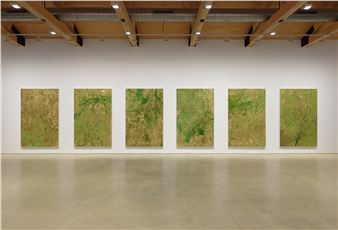Mark Grotjahn: Pink Cosco
Gagosian Gallery is pleased to present “Pink Cosco,” an exhibition of new, large-scale painted bronze sculptures by Mark Grotjahn.
Grotjahn's work is inseparable from its present moment, yet willing to make explicit art-historical reference. He borrows from Op art, Abstract Expressionism, Pop art, and Renaissance perspective, but achieves effects that reach forward and backward simultaneously. To occupy this precarious past-future visual position requires intense concentration, calculation, and control. As he painted his Butterfly paintings, Grotjahn sought an escape from precision: he began making masks out of the cardboard boxes lying around his studio—the discarded shells of art materials, gifts, and other packaging. He painted the boxes and attached toilet paper roll tubes that stuck out between cut-out eyes. The Masks, although originally started as a casual practice, quickly asserted themselves as a new armature for painting—an armature that would straddle time just as much as the two-dimensional geometric works.
The Masks unearth Cubism's methodical efforts to occupy, represent, and envelop space. Grotjahn started casting them in bronze in 2010—a material transformation that took the Masks away from ephemerality towards sequential permanence. What was once an intimate exercise is thickened, stabilized, and filled with formal artistic authority. “Pink Cosco” is Grotjahn's first exhibition of sculpture in which every work is the same form. It takes its title from a box that contained a Cosco brand stepladder. While Grotjahn used the ladder to reach and paint surfaces, its box offered a new surface on which the practice of painting could be reconsidered.
The Masks in “Pink Cosco” are faces stretched tall. Despite their material, they maintain their identity as convertible containers, but offer no real entry. Lined up atop wooden pedestals, they stare down their long, phallic noses. Their color scheme is kept to pink or yellow only: a formulaic restriction that, like the Butterfly series, reveals the variations inherent to any repetition. The Masks stand proudly, their original vulnerability replaced by layers of paint thickly applied over polished bronze. Boldly signed and dated, the works unite Grotjahn's various styles and turn private practice into public display. This progression runs parallel to history itself: even without intention, each object and subject is inhabited by a history that it cannot shake off.

Recommended for you
Gagosian Gallery is pleased to present “Pink Cosco,” an exhibition of new, large-scale painted bronze sculptures by Mark Grotjahn.
Grotjahn's work is inseparable from its present moment, yet willing to make explicit art-historical reference. He borrows from Op art, Abstract Expressionism, Pop art, and Renaissance perspective, but achieves effects that reach forward and backward simultaneously. To occupy this precarious past-future visual position requires intense concentration, calculation, and control. As he painted his Butterfly paintings, Grotjahn sought an escape from precision: he began making masks out of the cardboard boxes lying around his studio—the discarded shells of art materials, gifts, and other packaging. He painted the boxes and attached toilet paper roll tubes that stuck out between cut-out eyes. The Masks, although originally started as a casual practice, quickly asserted themselves as a new armature for painting—an armature that would straddle time just as much as the two-dimensional geometric works.
The Masks unearth Cubism's methodical efforts to occupy, represent, and envelop space. Grotjahn started casting them in bronze in 2010—a material transformation that took the Masks away from ephemerality towards sequential permanence. What was once an intimate exercise is thickened, stabilized, and filled with formal artistic authority. “Pink Cosco” is Grotjahn's first exhibition of sculpture in which every work is the same form. It takes its title from a box that contained a Cosco brand stepladder. While Grotjahn used the ladder to reach and paint surfaces, its box offered a new surface on which the practice of painting could be reconsidered.
The Masks in “Pink Cosco” are faces stretched tall. Despite their material, they maintain their identity as convertible containers, but offer no real entry. Lined up atop wooden pedestals, they stare down their long, phallic noses. Their color scheme is kept to pink or yellow only: a formulaic restriction that, like the Butterfly series, reveals the variations inherent to any repetition. The Masks stand proudly, their original vulnerability replaced by layers of paint thickly applied over polished bronze. Boldly signed and dated, the works unite Grotjahn's various styles and turn private practice into public display. This progression runs parallel to history itself: even without intention, each object and subject is inhabited by a history that it cannot shake off.












